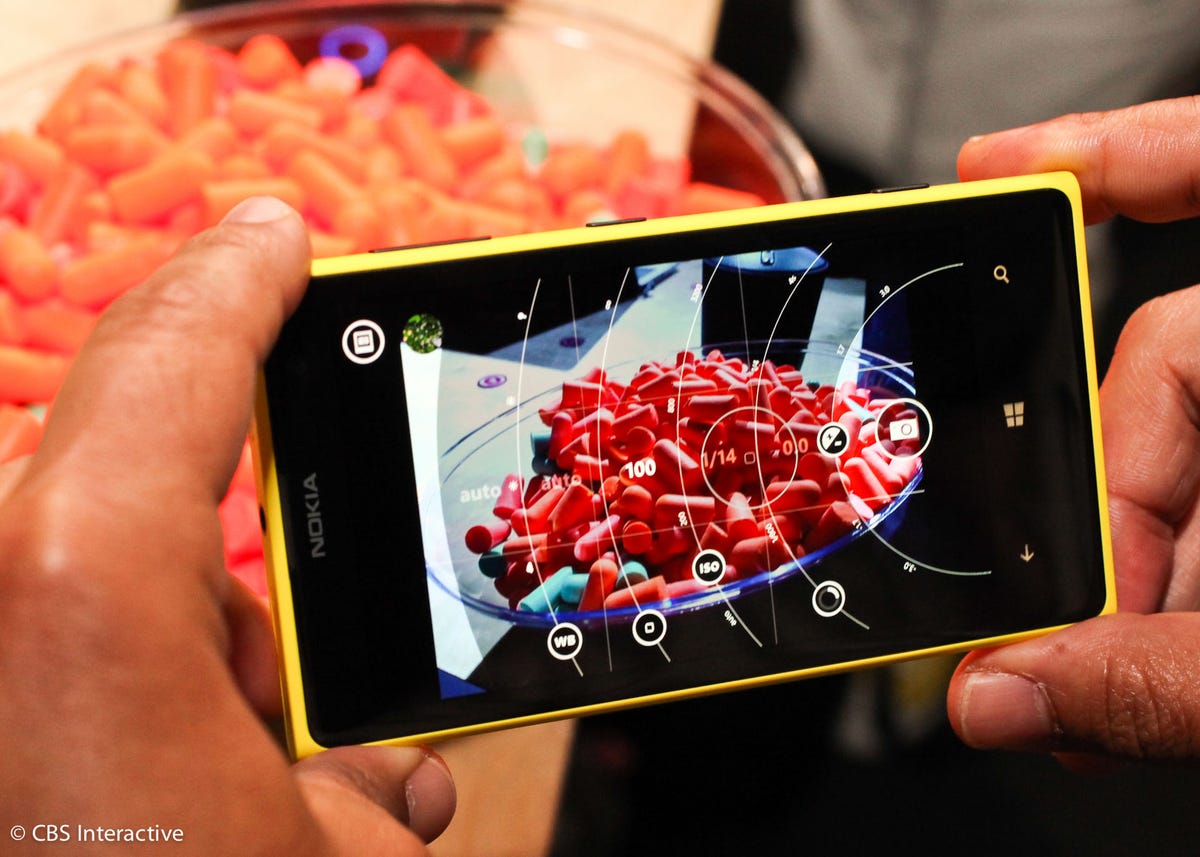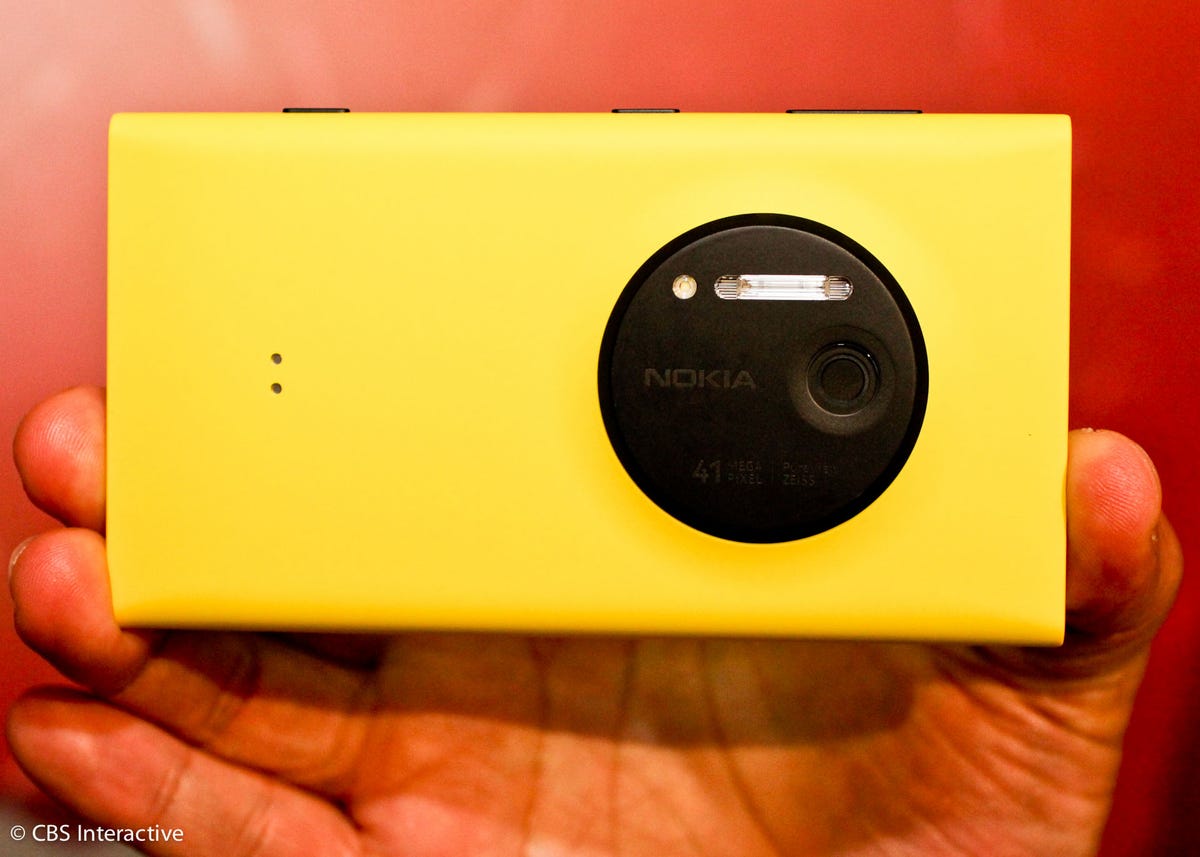Could Nokia’s new 41-megapixel Lumia 1020 be the best smartphone for shutterbugs?

I love taking pictures. But I can’t tell you the last time I carried around a point-and-shoot camera.
I almost exclusively use my smartphone for most of my picture taking needs nowadays. But to be perfectly honest, I am often disappointed in the images. Unless it’s an immaculately sunny day, with excellent conditions for taking photos, the shots from my Galaxy S3 often look blurry or overexposed.
This is why Nokia’s new 41-megapixel Lumia 1020 sounds so appealing. But is the device really worth the hype? And more importantly, is it worth ditching Apple iOS or Google Android for Microsoft Windows Phone or leaving your existing carrier for AT&T to get your hands on the device?
In this edition of Ask Maggie, I offer my opinion on these questions.
Is the Nokia Lumia 1020 all that?
Dear Maggie,
I am a Verizon Wireless customer and I’m looking for a new smartphone. My current phone is a Motorola Droid 2, but I’m ready for a new device. While I like Motorola phones for the most part, the cameras on the devices I’ve had suck. So I really like the idea of the new Nokia Lumia 1020. My wife is having a baby soon, and I don’t own a point-and-shoot camera. So I’d like something that isn’t as crappy as the current smartphone camera I have now.
One of the biggest issues for me is that I’m happy with Android, and I don’t think I want to move to Windows Phone. But if the camera on the Lumia 1020 is as good as it sounds, and if it’s really better than the upcoming camera on the Motorola X or Samsung Galaxy S4 or HTC One, maybe I should consider it. Right?
What do you think? Is the camera on the Lumia 1020 cool enough for me to leave Android and all its Google conveniences? Also, do you think the Lumia 1020 will come to Verizon soon?
Thanks, MDG
Dear MDG,
First of all congratulations on the upcoming baby! I’m in your exact same boat. Well, I guess my husband is in your same boat. (I’m in your wife’s boat.) We’re also expecting a baby. It’s our first, so I’m no expert on being a parent and all the gear you should own. But from what I hear, having a good camera on hand is right up there with a good stroller. The little tots grow up quickly, and you’ll definitely want to document it all.


Sarah Tew/CNET
Owning a big digital SLR is nice for getting some terrific photos. I have one, and I love it. But it’s bulky and heavy. And I find myself leaving it at home more often than I feel like lugging it along in my daily life. I can only imagine how inclined I’ll be to carry it around with me once I have a baby in tow.
I have a smaller point-and-shoot camera, but even carrying that around is not as convenient as just using my smartphone to take quick snapshots. My guess is that most people are like me. And that’s why smartphones have definitely become the camera of choice for lots of parents I know. But as you point out, and as Nokia CEO Stephen Elop noted yesterday during the Lumia 1020 press conference, smartphone photography doesn’t always produce the best images.
So what’s a new parent to do? The Nokia Lumia 1020 is no doubt an impressive device with a camera sporting a 41-megapixel sensor. And it’s definitely worth putting on your list to consider, if camera quality is at the top of your must-have list for a new smartphone. But I’m going to be honest with you, it’s hard to say for certain how the device’s camera stacks up against other smartphone cameras, since it hasn’t been fully reviewed yet.
The Apple iPhone 5, Samsung Galaxy S4, and HTC One have all been praised for their strong camera chops. Then there’s the new Samsung Galaxy S4 Zoom, a spin-off of the original GS4, which has an optical lens that actually zooms out of the camera. It’s a bit bulkier than other smartphones, but it’s definitely a device to be considered if the camera is really a deal-breaker in your quest for a new smartphone.
Even though it’s hard to pick a winner right now, CNET Reviews editor Josh Goldman read through Nokia’s white paper describing the Lumia 1020’s technology and offered his analysis. The 41-megapixel camera and the technology behind it are an enhancement to a previous Nokia device called the PureView 808, which was based on Nokia’s old operating system, Symbian.
Josh, who previously reviewed the PureView 800, called that phone one of the best, if not the best, smartphone cameras out there. And in his most recent post, he explains why he thinks the Lumia 1020 will likely be equally as impressive.


Sarah Tew/CNET
There are three main things that make the Lumia 1020’s technology unique: the oversampling technology, which allows for very detailed images and cropping of photos; improved sensor and flash for low-light picture taking; and manual settings that allow you to adjust settings such as white balance, ISO (100-3200), exposure compensation, shutter speed (4 seconds to 1/16,000 second), and focus.
Is it worth it? The big question, of course, is whether all this whiz-bang technology is really worth it. And how useful is it to the average shutterbug? I asked Sarah Tew, CNET’s photographer who was at the press conference, what she thinks. Sarah is not a device reviewer nor is she a writer. And she wouldn’t describe herself in any way, shape, or form as a gadget geek. She’s a professional photographer, who takes photos of products and events for CNET, as well as runs her own photography business taking portraits and photographing weddings.
Sarah’s take was interesting to me, because I think her perspective represents what a lot of consumers who love photography will think about this device. She isn’t easily impressed by technology for technology’s sake. She doesn’t necessarily care about which processor is in the device or how many cores that processor has. She just wants a device that’s easy to use, offers her the apps and services she needs, and takes quality pictures. Currently, she’s using an older Android phone. But she admits she’s also in the market for a new smartphone with a better camera.
Her first comment after seeing the demonstrations of the Lumia 1020 was that she thinks 41 megapixels is overkill for just about any camera. And indeed it might be. But CNET camera reviews editor Josh Goldman explains in his piece that the 41 megapixel sensor, which actually captures raw images at 38 megapixels or 39 megapixels depending on the aspect ratio, is really about giving people the opportunity to be able to zoom in much closer on images and not lose details.
The main reason for such a high-resolution sensor is for pixel oversampling. Nokia’s algorithms collect data from multiple pixels to create what it calls a superpixel. These superpixels deliver a more accurate representation of the subject while also helping eliminate image noise in low-light conditions and make noise virtually nonexistent when shooting in good lighting. The end result is some really good 5-megapixel photos.
More importantly, the pixel oversampling gives the 1020 a better digital zoom. Basically, as you zoom in, the amount of oversampling reduces until you’ve reached the limit of the actual resolution. In other words, if you are shooting at 5 megapixels, you can continue to zoom until it’s no longer oversampling and simply using a 5-megapixel area of the sensor. There is no upscaling or interpolation, it’s just a 5-megapixel photo.
At that resolution, it will give you about a 3x digital zoom for photos and a 4x zoom for movies shot in 1080p or 6x recording at 720p. (More details on how it all works can be found in this post on the 808 or in the white paper for the Lumia 1020.


This is all well and good, but Sarah points out that storing 38 or 39 megapixel images takes up a lot space, particularly if you’re a prolific photographer. In fact, that’s why the Lumia 1020 also stores the same image at 5 megapixels. This allows for easy sharing of pictures on social-media sites, such as Facebook and Twitter.
These supersize photo files are also why the Lumia 1020 comes with 32GB of on-device storage.
While 32GB sounds like a lot of storage, the big question is whether that’s really enough with such large image files. I asked Matt Rothschild, head of North America sales and marketing for Nokia, this very question. He said that with this amount of memory, users could store up to 1,700 pictures at the full resolution. Of course, it will likely be able to store far fewer images at these resolutions if you’re also storing a lot of apps, videos, and/or music on your device. There’s no separate slot for off-device storage, such as a mini USB card.
To help alleviate this issue, Rothschild said Lumia 1020 users can also automatically store images to AT&T’s cloud-based locker service or the SkyDrive service offered by Microsoft. AT&T’s service offers up to 50GB of storage, while Microsoft’s SkyDrive offers 7GB for free. The device can be set up to automatically upload pictures to these storage services either over the carrier network or when users are in Wi-Fi mode.
Another complaint Sarah has is that the software settings to operate the camera may be too complicated both for the basic functions and for the more advanced settings. For instance, she said she’d much rather have a device that works just like a point-and-shoot camera with a simple button you push that lets you autofocus by pushing halfway down and then snapping the picture. A grip and case can be added to the device to provide a more cameralike experience, but you have to pay an additional $70 for it. Sarah also said the advanced settings, which require a lot of fiddling with the screen, could be greatly simplified.
Of course, this is just one photographer’s opinion. And when it comes to smartphones, the devices are phones first and cameras second. So some of the issues she had with making the device more simple could be more a function of the fact that this is a phone and not a regular point-and-shoot camera.
Still, I think her gut feeling about this device is worth noting, especially in light of the fact that you’d have to give up the Google Android ecosystem in order to get this device with the fancy camera features.
Nokia Lumia 1020: A camera phone powerhouse (pictures)






Moving to Windows Phone from Android As you noted in your question, the Lumia 1020 is a Windows Phone device. It runs Microsoft’s Windows Phone 8 operating system. In some ways, I think I prefer the look and feel of Windows Phone to either Google’s Android or Apple’s iOS. But picking one platform over another is often less about the user interface of the software and more about the apps and service integration with those devices.
As many people before me have pointed out, the app ecosystem on Windows Phone is not as advanced as those on the other two big mobile ecosystems, Android and iOS. And for some people this might not matter much, given that most people tend to use only a small number of apps. If you can access the apps you actually use, then the total number of apps in any given app store shouldn’t matter much.
But where Windows Phone 8 is handicapped compared with Android, especially, is in its integration of Google services. Our lives are not only lived on mobile devices, but people use other Internet-based devices too to run their lives. As such, many people use Google for e-mail, search, online calendars, synced contacts, maps, storage, and more. Microsoft has managed to add integration into Windows Phone 8 for some of these services. But the integration is sometimes clunky. The reality is that Microsoft really wants people using its own search, e-mail, storage, and other services on their mobile devices instead of Google’s services.
The result is that accessing all these Google services, if you use Google to organize and run your life, is much easier on an Android device than it is on a Windows Phone handset. While it’s true that you can access some of the Google services on Windows Phone 8, it’s not going to be as smooth and it will likely take some work on your part to get it to work the way you want it. By contrast, on an Android device, accessing these services is as easy as signing in to your account, which you must do to activate your phone.
Of course, this isn’t an issue for people who are already using Microsoft services or who are new to smartphones and cloud-based services and are willing to invest themselves in Microsoft’s ecosystem.
It sounds from your question like you may already be heavily invested in Google and Android. With that in mind, you have to ask yourself what’s more important: a superior camera with a lot of fancy technology? or a device that’s already compatible with all the services you currently use to run your life? Only you can answer that question for yourself.
Is AT&T truly the only choice for those interested in the Lumia 1020? The ultimate deal-breaker for you and many others who’d like to consider the Lumia 1020 may be the fact that the phone will be available only on AT&T. Yesterday, Nokia CEO Stephen Elop said during the press conference that AT&T would be the “first” carrier to offer the Lumia 1020. But then AT&T’s head of mobile, Ralph de la Vega, took the stage and said the phone would be “exclusive” to AT&T.
I asked Nokia’s Matt Rothschild to clarify whether consumers could expect a Lumia 1020 to come to other carriers in the future. And he very solidly said that no other U.S. carrier will get the Lumia 1020. He said the company is satisfied with its current strategy of building phones that are exclusive to certain carriers.
He pointed to the fact that the company recently launched the Lumia 928 exclusively on Verizon. And that T-Mobile has its own version, the Lumia 925. He also said that the Lumia 1020 will not be sold unlocked in the U.S. So even consumers willing to buy the device at full price in the U.S. will still have to use it on AT&T, unless they’re able to unlock it themselves.
Personally, I think this strategy is a mistake for Nokia. The company should be trying to get this device in the hands of as many potential customers as possible. The three hottest handsets on the market today are the Apple iPhone 5, the Samsung Galaxy S4, and the HTC One. These companies have made the exact same device available on almost every major carrier. (Verizon is still waiting to get the HTC One.)
What this means for consumers is that they’re not limited in the handsets they can buy because they’re on a certain carrier. It opens up the market to a lot more potential customers.
But Nokia’s Elop told my colleague Roger Cheng in an interview that the exclusive handset deals are part of a bigger strategy for the company. He said lackluster sales of earlier Lumia products that were exclusive to AT&T were not AT&T’s problem but Nokia’s and Microsoft’s problems. He seemed to imply that it could be different this time around.
The real reason Nokia is likely still selling devices exclusively by carrier is because it can’t afford to market its devices on its own. It needs AT&T and Microsoft to help split the cost of the hefty marketing needed to get this device even modest sales. The reality is that wireless carriers, which still think exclusive handset deals lure consumers to their networks, are more likely to contribute money, shelf space, and people power to marketing these devices if they can say they’re the only ones offering them.
The bottom line So what does all this mean for you? Unless you’re willing to switch to AT&T, you won’t be able to get this device anyway. But let’s say you’re willing to switch carriers. I’d recommend reading formal reviews of the device before you buy it. It’s not expected to launch on AT&T until July 26, so there’s time to get more information on the device.
If the camera quality is truly superior to that of other devices out there, then I’d say consider the Lumia 1020. Keep in mind it’s about $100 more expensive, even with a two-year AT&T service contract, than the other top-selling smartphones. But if getting the best camera on a smartphone is what’s most important to you, then this device could be the one.
Good luck with your decision on a new device, and good luck with the new baby when he or she arrives!
Ask Maggie is an advice column that answers readers’ wireless and broadband questions. The column now appears twice a week on CNET offering readers a double dosage of Ask Maggie’s advice. If you have a question, I’d love to hear from you. Please send me an e-mail at maggie dot reardon at cbs dot com. And please put “Ask Maggie” in the subject header. You can also follow me on Facebook on my Ask Maggie page.



